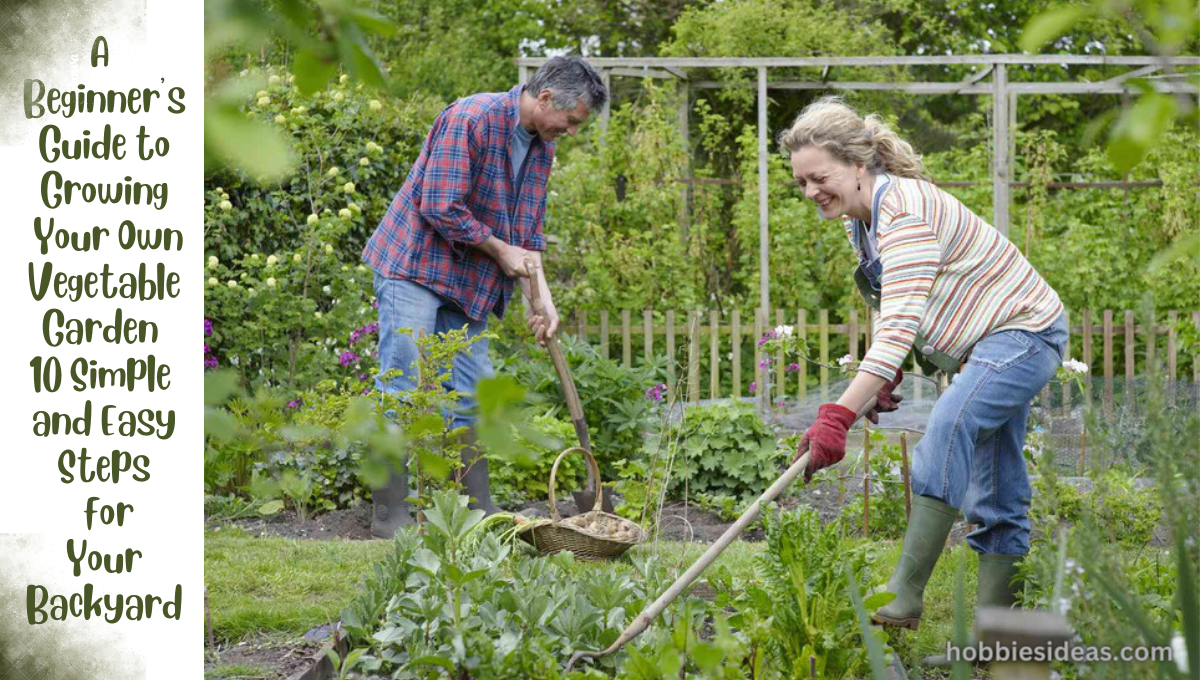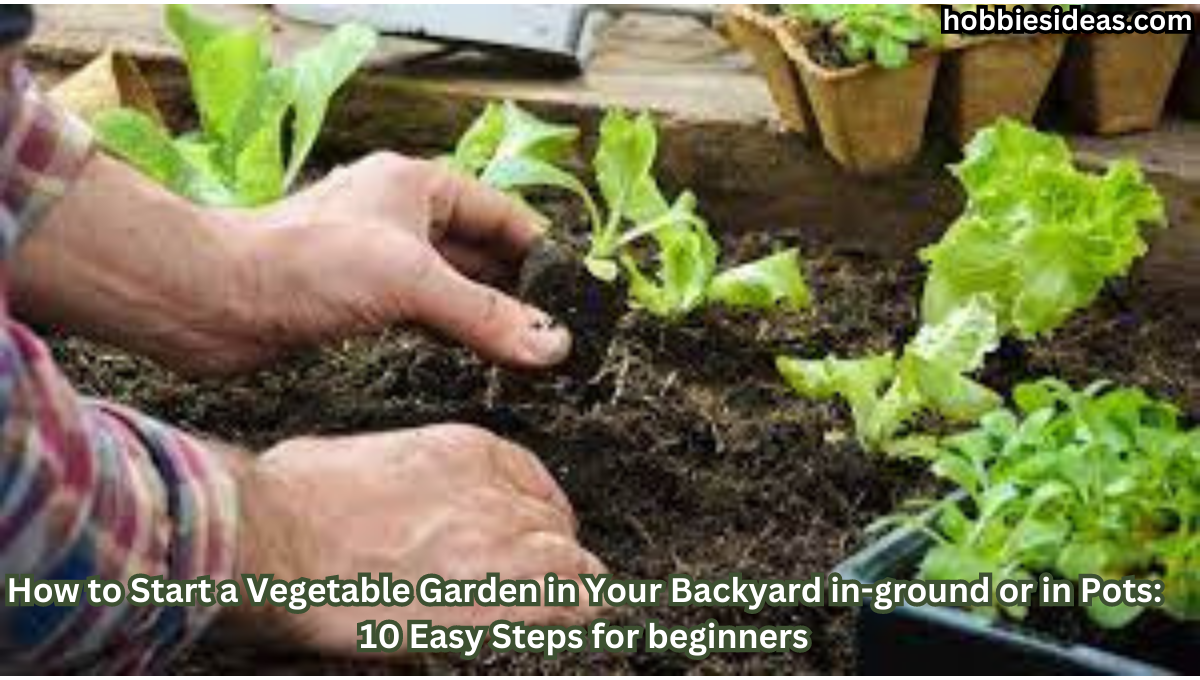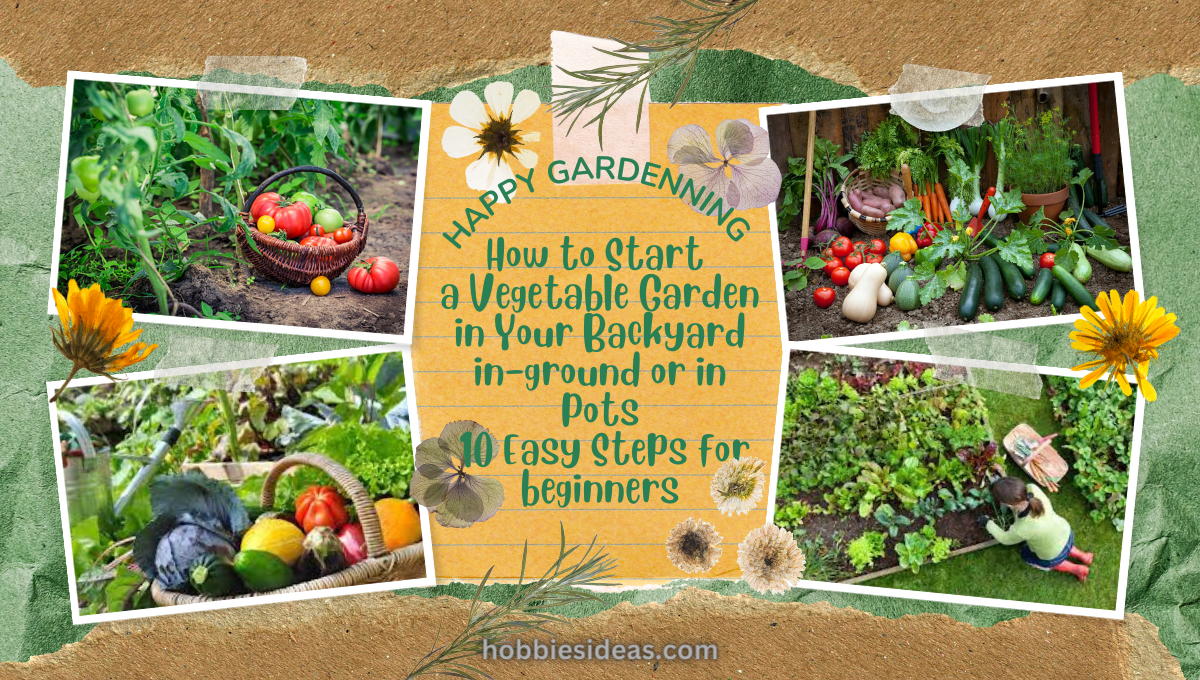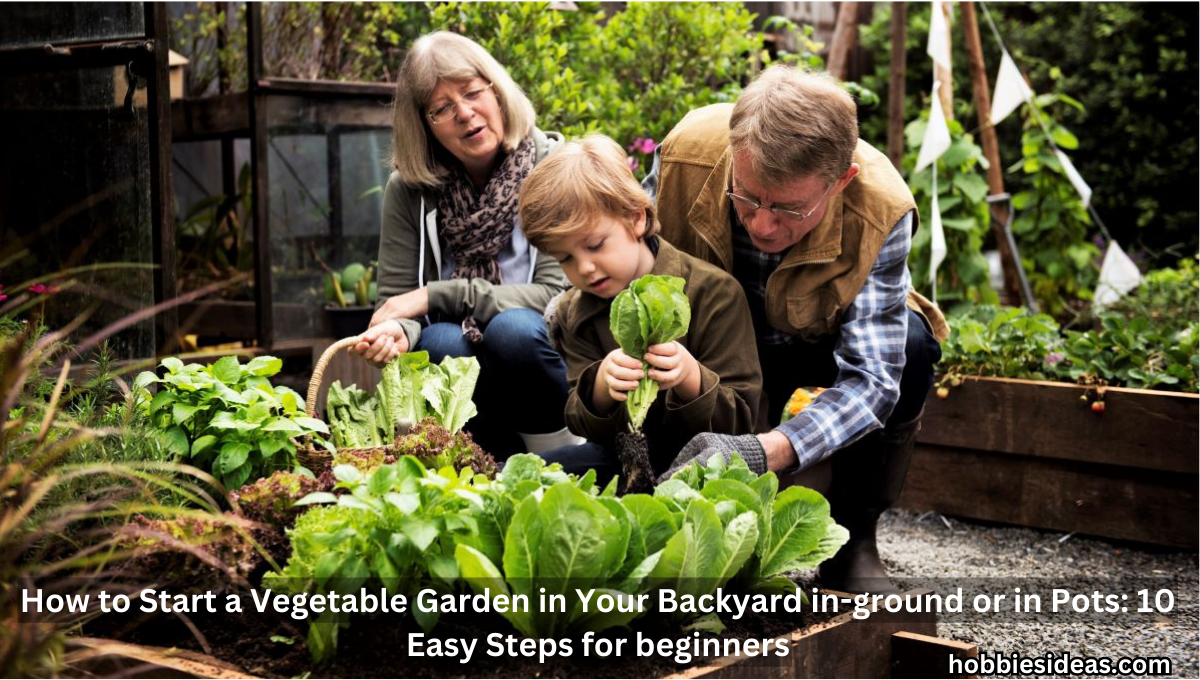Are you tired of store-bought veggies that lack flavor and freshness? Why not take matters into your own hands and start a vegetable garden in your backyard? You will enjoy the satisfaction of growing your food and reap numerous benefits from growing beans and other veggies in your garden. Plus, you can even start growing seeds indoors for an early start to your garden.
Before diving headfirst into vegetable gardens, planning and preparing is crucial. This ensures that your garden bed is ready for planting and maximizes your chances of success. From choosing the perfect plot to creating a well-thought-out garden plan, each step, including stagger plantings and starting seeds indoors, plays a vital role in yielding bountiful harvests.
Timing is everything when it comes to your garden plans. By following the recommended depths for planting seeds and spacing your veggies an inch apart, you’ll set yourself up for triumph. Don’t forget to use a garden planner to help you stay organized and make the most of your test garden tips.
So why wait any longer? Let’s dive into the world of planting vegetables in backyard gardens, where every step counts towards a flourishing harvest of season vegetables.
Selecting the Perfect Location for Your Vegetable Garden
Selecting the perfect location for your vegetable garden is crucial for the success of your veggies. The right spot can ensure healthy plant growth, abundant harvests, and a thriving garden. Here are some factors to consider when planning the ideal location for your gardens and crops.
Importance of Sunlight Exposure for Healthy Plant Growth
When choosing a location for your vegetable garden, consider sunlight exposure. Veggies need at least six hours of sunlight daily for healthy leaf development and fruitful crops. Sunlight is essential for photosynthesis.
Observe how sunlight moves across different areas during the day to determine the sunniest spots in your yard for vegetable gardening. Take note of large trees or structures that may cast shadows on potential vegetable garden locations. Aim to choose a size that receives ample sunlight throughout the day for optimal plant vegetable growth.
Factors to Consider When Choosing the Location
In addition to sunlight exposure, there are other factors you should consider when planning the location of your vegetable garden. These factors include the type of veggies you want to grow, the condition of the soil, and the proximity to other crops. It’s also essential to consider the surrounding grass and how it may affect the growth of your veggies.
- Proximity to Water Source: When selecting a site for your vegetable garden, ensure it is conveniently located near a water source. This will simplify the irrigation process and help maintain optimal moisture levels in the soil. Using a garden planner can also assist with organizing your vegetable gardens effectively.
- Accessibility: Opt for a location near pathways or entrances to easily access your vegetable gardens. This way, you can tend to your veggies without any hassle. Consider the proximity to grassy areas or fences where you can easily reach your garden.
- Soil Quality for Vegetable Gardens: Evaluate the soil quality in potential garden locations before deciding. Look out for well-draining soil with good fertility and organic matter content. Avoid areas with heavy clay or compacted soil, which can hinder root growth. Ensure the earth is suitable for growing veggies and free from grass or other obstructions. Consider installing a fence to protect your vegetable garden from pests and animals.
Tips for Evaluating Soil Quality in Potential Garden Locations
Use this test garden tip to assess soil quality in different areas of your backyard. Utilize a garden planner to keep track of the results. Pay attention to the grass and fence areas as well.

- Dig small test holes around potential grass sites and examine the texture and color of the soil. Make sure to check for any signs of damage to the fence. Once you have gathered all the necessary information, you can reply to the homeowner with your findings.
- Check for rocks, debris, or excessive sand that may affect drainage and nutrient retention in the grass and around the fence.
- Consider conducting a soil test to determine your grass’s pH level and nutrient composition. This will help you understand if any amendments are needed for your fence. You can choose the perfect location for your vegetable garden. Remember to plan using a garden planner or sketch your ideas on paper. Once you have finalized the site, it’s time to prepare the soil and select the vegetables that best suit your chosen location.
Preparing Your Soil for a Successful Vegetable Garden
Soil preparation, including fence installation, is crucial for optimal plant growth and a successful vegetable garden. Properly preparing your garden soil provides nutrients and conditions for your vegetable plants to thrive.
Importance of Soil Preparation
Before you begin planting vegetables in your garden, it is essential to understand the importance of soil preparation. An adequately prepared soil with a fence provides a healthy environment for vegetable plants to grow strong roots, absorb nutrients efficiently, and resist diseases. It also improves water drainage and prevents waterlogging or root rot.
Improving Soil Fertility
There are various effective ways to enhance the fertility of your garden soil, including using a fence. One popular method is composting, which involves recycling organic materials like kitchen scraps, leaves, and grass clippings into nutrient-rich compost. Adding this compost to your garden beds helps improve soil structure, moisture retention, and nutrient content.
Another way to boost fertility is by incorporating organic matter into the soil. Organic matter is a natural fertilizer that enriches the ground with essential nutrients over time. You can use well-rotted manure or aged compost to increase organic matter content in your garden soil. A fence around your garden can help protect it from pests and animals that may damage your plants.
Testing and Amending Soil pH Levels
Different vegetable crops have specific pH requirements for optimal growth. Testing your soil’s pH level allows you to determine if it falls within the suitable range for the vegetables you plan to grow. Acidic soils (pH below 7) may require amendments like lime to raise their pH level, while alkaline soils (pH above 7) may need sulfur or peat moss to lower their pH level. It is essential to consider the pH of your soil when planning to grow vegetables in your garden, as it can significantly impact their growth and overall health.
To accurately test the pH level of your garden’s soil, follow these steps and include a fence.
- Purchase a soil testing kit or pH meter from your local garden center to test the soil near your fence.
- Collect soil samples from various areas of your garden, avoiding areas with recent fertilization near the fence.
- Follow the instructions provided with the testing kit or pH meter to obtain accurate readings for your fence.
- Based on the results, add appropriate materials like lime or sulfur. Ensure the fence is installed correctly to protect the soil and plants.
Companion Planting and Crop Rotation
In addition to improving soil fertility and pH levels, considering companion planting, crop rotation, and fence techniques can further enhance your vegetable garden’s success. Companion planting involves strategically growing certain plants to benefit each other in terms of pest control, pollination, and nutrient sharing.
Crop rotation is another essential practice that helps prevent soil disease build-up and nutrient depletion. By rotating crops each season, you can disrupt pest life cycles and reduce the risk of diseases affecting specific plant families.
Starting Your Plants: Seeds or Seedlings and Planting Techniques
Starting a vegetable garden in your backyard is an exciting endeavor, but one of the first decisions you’ll need to make is whether, to begin with seeds or seedlings. Each method has pros and cons, so let’s explore the options and discuss some planting techniques to help you get your garden off to a successful start.
Pros and Cons of Seeds vs. Seedlings
Sowing seeds directly in your garden can be a cost-effective option, mainly if you have limited space or want to grow a wide variety of vegetables. Seed packets are readily available at local nurseries or through online seed catalogs, offering an extensive selection for you to choose from. Starting from seeds allows you to witness the entire growth process from germination.
However, it’s important to note that growing plants from seeds requires more time and effort compared to using seedlings. You’ll need to provide optimal conditions for germination indoors or directly in the garden. Indoor germination involves providing adequate light, temperature control, and moisture levels until the seedlings are ready for transplanting outdoors.
On the other hand, utilizing seedlings or transplants offers several advantages. These young plants have already passed their delicate germination stage and are more resilient when transplanted into your garden. This method allows you to save time as well since you’re skipping the initial stages of growth.
Tips for Successful Seed Germination
If you decide to start with seeds, there are a few tips that can help ensure successful germination:
- Indoor Germination: Sow your seeds indoors in small pots or trays filled with a good-quality potting mix. Keep them warm near a sunny window or using artificial lights.
- Watering: Be mindful not to overwater, as excessive moisture may lead to the rotting of plant roots. Water gently using a spray bottle or a watering can with a fine nozzle.
- Seed Depth: Follow the instructions on the seed packet to determine the appropriate depth for sowing each type of seed. As a general guideline, smaller seeds require shallower planting depths.
- Thinning Seedlings: Once your seedlings have sprouted, thin them out if they are overcrowded. This ensures that each plant has enough space to grow and access necessary resources.
Planting Techniques for Healthy Growth
Proper planting techniques are crucial for healthy growth. Consider the following factors when planting your vegetables:
- Spacing: Different vegetables have varying spacing requirements to allow adequate airflow and prevent overcrowding. Consult gardening resources or seed packets for specific recommendations.
- Depth: Planting depth is another critical factor. Some seeds need to be planted shallowly, while others require deeper burial. Again, refer to the seed packets for guidance.
- Watering: Provide sufficient water after planting to help plants establish their roots. Avoid overwatering, as it can lead to root rot and other issues.
- Staggered Plantings: Considers staggering plantings by sowing or transplanting seedlings at different intervals. This way, you’ll have a continuous supply of fresh produce throughout the growing season.
Protecting Your Garden: Dealing with Pests and Diseases
Having a vegetable garden in your backyard is a rewarding experience. However, protecting your hard work from pests and diseases that can wreak havoc on your plants is essential.

Identifying Common Pests
Pests are one of the biggest challenges faced by gardeners. Recognizing common problems is crucial for adequate control. Here are some pesky intruders you may encounter in your vegetable garden:
- Aphids: These tiny insects suck the sap out of plants, causing stunted growth and distorted leaves.
- Slugs and Snails: These slimy creatures feast on tender plant leaves, leaving holes and slime trails behind.
- Tomato Hornworms: These large green caterpillars devour tomato plants, defoliating them rapidly.
- Cabbage Worms: The larvae of white butterflies, cabbage worms munch on cabbage family crops like broccoli and kale.
Organic Pest Control Methods
Organic methods are not only practical but also environmentally friendly. Consider these natural pest control techniques:
- Companion Planting: Certain plants repel pests or attract beneficial insects that prey on them. For instance, marigolds deter aphids while attracting ladybugs.
- Natural Repellents: Homemade sprays using ingredients like garlic or neem oil can repel unwanted insects without harming beneficial ones.
- Physical Barriers: Installing fences or netting around your garden can keep larger pests like rabbits or deer at bay.
Strategies for Disease Prevention
Diseases can quickly spread among your vegetable plants without proper precautions. Follow these strategies to minimize the risk:
- Sanitation Practices: Start by removing any diseased plant material promptly. Dispose of it away from your garden to prevent further contamination.
- Crop Rotation: Avoid planting the same vegetable family in the same spot each year. This practice helps break the disease cycle as pathogens specific to a plant are less likely to build up in the soil.
- Proper Watering: Overhead watering can increase humidity, creating favorable disease conditions. Instead, water at the plants’ base or drip irrigation to keep foliage dry.
- Weed Control: Weeds compete with your vegetable plants for nutrients and can harbor pests and diseases. Regularly remove weeds from your garden beds to reduce potential problems.
Implementing these strategies protects your vegetable garden from pests and diseases, ensuring healthy and thriving plants throughout the growing season.
Remember, maintaining a healthy garden requires vigilance and regular monitoring. Keep an eye out for any signs of trouble, such as chewed leaves or wilting plants, so you can take immediate action if needed. With proper care and attention, your backyard vegetable garden will flourish and provide you with bountiful harvests year after year.
Maximizing Yield in Small Gardens: Tips for Space Optimization
Creative Ways to Maximize Limited Space
Space can often be a limiting factor. However, you can make the most of even minor areas with creative thinking and innovative techniques. Here are some test garden tips for maximizing yield in small gardens through space optimization:
Vertical Gardening
One effective way to maximize limited space is through vertical gardening. You can grow vegetables vertically instead of horizontally by utilizing walls, fences, or trellises. This saves precious ground space and adds an aesthetic appeal to your garden.
Consider these tips for vertical gardening:
- Install sturdy trellises or wire mesh against a wall or fence.
- Choose vining plants such as cucumbers, beans, or tomatoes that naturally climb and thrive in tight spaces.
- Use hanging baskets or tiered planters to create layers of greenery.
Container Gardening
Another option for small gardens is container gardening. This technique allows you to grow vegetables in pots or containers rather than directly in the ground. It offers flexibility and mobility since you can quickly move the containers around according to sunlight requirements.
Here’s how you can optimize space with container gardening:
- Select appropriate-sized containers based on the mature size of your chosen vegetables.
- Ensure proper drainage by drilling holes at the bottom of each container.
- Place containers strategically to make use of available sunlight.
- Consider stacking containers vertically using shelving units or repurposed pallets.
Companion Planting Techniques
In addition to space optimization strategies like vertical and container gardening, companion planting techniques can enhance yield and promote healthier growth among your vegetable crops.
Companion planting involves growing compatible plants together so they mutually benefit from one another’s presence. Some popular combinations include:
- They are planting marigolds near tomatoes to repel pests and attract beneficial insects.
- I am pairing basil with peppers to enhance flavor and deter harmful pests.
- They are growing radishes alongside cucumbers to discourage cucumber beetles.
Maximizing Productivity with Succession Planting
Consider implementing succession planting in your small garden to ensure a continuous harvest throughout the growing season. This technique involves sowing or transplanting seedlings in multiple stages, allowing for a staggered maturity schedule.
Follow these steps for successful succession planting:
- Determine the average maturity time of each vegetable you plan to grow.
- Calculate the ideal gap between plantings based on the crop’s growth cycle.
- Start with an initial planting, then make subsequent plantings at regular intervals according to your calculated gaps.
- Harvest mature plants as needed while younger ones continue to develop.
You can maximize yield even in small gardens by employing these space optimization techniques, such as vertical gardening, container gardening, companion planting, and succession planting. So get creative with your limited space and enjoy a bountiful harvest from your backyard vegetable garden!
Watering and Mulching: Maintaining Moisture Levels and Nutrient Retention
Proper watering techniques are crucial. Different plants have varying water requirements, so it’s essential to understand their needs based on the specific type of plant, weather conditions, and soil type. Overwatering can lead to root rot and other issues, while underwatering can stunt growth or even kill the plants. Here are some tips for watering your vegetable garden effectively:
- Observe plant needs: Pay attention to each plant’s water requirements by regularly checking the soil moisture level. Stick your finger about an inch into the soil near the base of the plants. If it feels dry at that depth, it’s time to water.
- Water deeply: Instead of frequent shallow watering, provide a deep soak once or twice a week. This encourages healthy root development as roots grow deeper in search of moisture.
- Time watering properly: Water early in the morning or late in the evening when temperatures are more relaxed. This minimizes evaporation and allows plants to absorb moisture more efficiently.
- Consider drip irrigation: Drip irrigation systems deliver water directly to plant roots, reducing waste from evaporation and ensuring efficient hydration.
Mulching is another essential aspect of maintaining moisture levels and nutrient retention in your vegetable garden. Mulch acts as a protective layer on top of the soil, offering several benefits, such as conserving moisture, suppressing weeds, regulating temperature fluctuations, and improving overall soil health through organic matter decomposition.
When selecting mulch materials for different types of vegetables, keep these tips in mind:
- Choose organic mulch: Organic mulches like straw, wood chips, shredded leaves, or grass clippings break down over time and enrich the soil with nutrients.
- Consider compost: Using compost as mulch helps retain moisture and adds valuable organic matter to the soil, promoting healthy plant growth.
- Apply a thick layer: Apply a 2-4 inch mulch around your plants, ensuring it covers the entire root zone. This prevents weed growth and helps maintain consistent moisture levels.
- Avoid mulch compaction: Be cautious not to compact the mulch too tightly, as this can hinder water penetration and air circulation. Loosen the mulch occasionally to allow for proper airflow.
You can create an optimal environment for your vegetable garden’s growth and productivity by implementing proper watering techniques and utilizing suitable mulching practices. Remember to adjust watering schedules based on weather conditions and individual plant needs. With time and care, your backyard vegetable garden will flourish, providing fresh produce at your doorstep.
Enjoy the Fruits of Your Backyard Vegetable Garden
Congratulations on taking the first steps toward starting your very own vegetable garden in your backyard! By following the guidelines in this article, you are well on your way to enjoying a bountiful harvest of fresh and nutritious produce. Let’s recap some key points to ensure your success:

Selecting the Perfect Location for Your Vegetable Garden
Choosing the right location is crucial for the health and productivity of your plants. Consider factors such as sunlight exposure, soil quality, and proximity to water sources. Aim for at least six hours of direct sunlight daily to promote optimal growth.
Preparing Your Soil for a Successful Vegetable Garden
Healthy soil is the foundation of a thriving garden. Test your soil’s pH levels and amend it with organic matter like compost or aged manure to improve its fertility. Remove any weeds or debris that may hinder plant growth.
Starting Your Plants: Seeds or Seedlings and Planting Techniques
Decide whether to start from seeds or purchase seedlings from a local nursery. Follow proper planting techniques, ensuring adequate spacing between plants for healthy root development. Remember to provide support structures like stakes or cages for vining plants.
Protecting Your Garden: Dealing with Pests and Diseases
Pests and diseases can pose challenges in any garden, but various methods exist to combat them naturally. Encourage beneficial insects like ladybugs and lacewings, use companion planting techniques, and regularly inspect your plants for signs of trouble.
Maximizing Yield in Small Gardens: Tips for Space Optimization
Even if you have limited space, there are ways to maximize yield in your vegetable garden. Vertical gardening, intercropping, and succession planting can help make the most of every square inch available.
Watering and Mulching: Maintaining Moisture Levels and Nutrient Retention
Proper watering is essential for plant health. Water deeply and consistently, ensuring the soil is evenly moist but not soggy. Mulching helps retain moisture, suppress weeds, and regulate soil temperature.
Now that you have a solid understanding of how to start a vegetable garden in your backyard, it’s time to get your hands dirty! Don’t be afraid to experiment and learn from your experiences. Remember, every garden is unique, so adapt these guidelines to your specific conditions.
So gather your tools, select your favorite vegetables, and embark on this exciting food-growing journey. Enjoy the satisfaction of harvesting fresh produce from your backyard while reconnecting with nature and promoting sustainability.
Happy gardening!
FAQs
How long does it take to see results in my vegetable garden?
It depends on the type of vegetables you are growing. Some fast-growing crops like lettuce or radishes can be ready for harvest within weeks, while others may take several months.
Do I need to use chemical fertilizers in my vegetable garden?
No, chemical fertilizers are not necessary. Organic alternatives such as compost or aged manure provide nutrients to the soil naturally and promote healthier plant growth.
Can I grow vegetables in containers instead of a traditional garden bed?
Absolutely! Container gardening is an excellent option for those with limited space or poor soil quality. Just ensure that the containers have proper drainage holes and adequate sunlight exposure.
What can I do if pests attack my plants?
There are various natural methods to control pests in your garden. You can try using insecticidal soaps, companion planting with pest-repellent herbs, or introducing beneficial insects like ladybugs.
Is it possible to grow vegetables year-round?
In some regions with mild climates, growing vegetables throughout the year is possible. However, colder areas may require indoor gardening during winter months or utilizing cold frames and row covers for protection.

